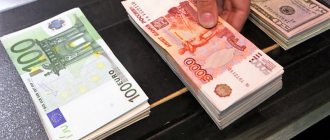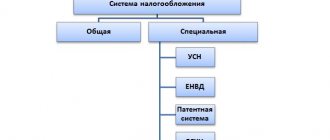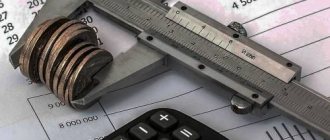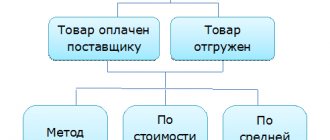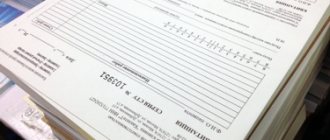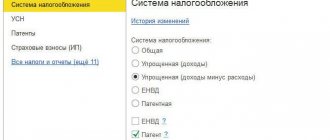The list of expenses (Article 346.16 of the Tax Code of the Russian Federation) that a tax payer of the simplified tax system can take into account includes expenses for the acquisition, construction and production of fixed assets, as well as for their completion, additional equipment, reconstruction, modernization and technical re-equipment. The costs of acquiring fixed assets are significant, so accounting errors can be costly to the taxpayer. Let's see how to properly account for expenses.
Fixed assets are part of the property used as means of labor for the production and sale of goods (performing work, providing services), for managing an organization or leasing, with a useful life of more than 12 months. The organization sets the initial cost of an object for classification as fixed assets for accounting purposes independently - the lower limit of the cost can be set no higher than 40,000 rubles.
Tax accounting of fixed assets is carried out only by simplified simplified tax systems “income minus expenses”. The fixed assets include property that is recognized as depreciable in accordance with Art. 346.16 Tax Code of the Russian Federation. The following conditions must be met:
- the property is owned or is an integral improvement to the leased property;
- the property is used to generate income;
- useful life exceeds 12 months;
- the initial cost of the OS exceeds 100,000 rubles (40,000 rubles until 2021);
The Tax Code requires that the initial cost of an asset include the costs of its acquisition, construction, manufacturing, delivery and bringing it to a state in which it is suitable for use. Additional costs that are included in the initial cost of the OS are the costs of state duty, installation, repairs (if the purchased OS requires repairs), and so on.
Accounting for fixed assets under the simplified tax system “income”
“Simplers” who have chosen the object of taxation “income” do not take into account any expenses for tax purposes (clause 1 of Article 346.18 of the Tax Code of the Russian Federation), therefore they cannot in any way reduce the tax due to expenses associated with the acquisition of fixed assets.
However, this does not mean that OS objects can be ignored. You will still have to keep records of fixed assets under the simplified tax system “income”. The fact is that the residual value of fixed assets is important as a criterion that allows you to switch to the simplified tax system and apply this particular special regime. All “simplified people” (as well as those who are just planning to switch to the simplified tax system) must comply with it equally, regardless of the chosen object of taxation. The Russian Ministry of Finance drew attention to this in its letter dated September 18, 2008 No. 03-11-04/2/140.
Let us recall that the threshold for the residual value of fixed assets, above which the application of the simplification is impossible, is established in subparagraph. 16 clause 3 art. 346.12 Tax Code of the Russian Federation. From 2021 it amounts to 150 million rubles. The residual value indicator is calculated according to accounting data.
NOTE! This limitation on the residual value of fixed assets applies to both organizations and individual entrepreneurs (see, for example, letter of the Ministry of Finance dated November 2, 2018 No. 03-11-11/78908).
When selling fixed assets, “profitable” “simplified” accounts for the corresponding proceeds in the generally established manner.
More details about this can be found in the material “ Procedure for selling OS under the simplified tax system “income” ” .
We fight for residual value
In case of “premature” sale of the OS, its residual value will be formed. In our example, it is equal to 450,000 rubles. (500,000 – 16,667 – 33,333). In Chapter 25 of the Tax Code of the Russian Federation there is a rule that allows you to reduce income from the sale of an object by its residual value (subclause 1, clause 1, article 268). But is it applicable “simplified”?
In a recent letter dated April 26, 2019 No. 03-11-11/30795, the Ministry of Finance responded negatively. They emphasized that Article 346.16 of the Code does not allow taking into account the residual value of fixed assets acquired under the simplified tax system or before the transition to this special regime and sold “ahead of time” in expenses. And this position is not new. Financiers have repeatedly expressed it before (letters dated 02/13/2015 No. 03-11-06/2/6557, dated 02/15/2013 No. 03-11-11/70, dated 03/03/2014 No. 03-11-11/8833, etc. .). Some arbitrators also think the same (see resolutions of the FAS of the Ural District dated March 24, 2008 No. F09-4976/07-S3, Volga District dated December 19, 2006 No. A57-181/06-7).
However, most of Themis’ servants have a different attitude. Take, for example, the Resolution of the Central District Court of June 23, 2017 No. F10-1838/2017. According to the judges, the indication in paragraph 3 of Art. 346.16 of the Tax Code of the Russian Federation on the need to recalculate the base for a single tax in accordance with the provisions of Chapter 25 of the Code allows for the application, inter alia, of the norm of subparagraph 1 of paragraph 1 of Article 268. A different interpretation of paragraph 3 of Article 346.16 of the Tax Code of the Russian Federation will lead to an unreasonable restriction of rights “ simplistic."
A similar point of view was expressed in many other verdicts (see, for example, resolutions of the Fourteenth AAS dated January 27, 2014 No. 14AP-11928AAS, FAS of the Ural District dated August 22, 2012 No. F09-7690/12 and dated November 14, 2012 No. F09-10644/12 , FAS of the Central District dated 06/09/2010 No. A14-19989/2009/668/24 and the Far Eastern District dated 06/19/2008 No. F03-A80/08-2/1669). It is important that the last two decisions were supported by senior judges (rulings of the Supreme Arbitration Court of the Russian Federation dated August 20, 2010 No. VAS-10870/10 and dated October 27, 2008 No. 13621/08).
It is possible that extensive arbitration in favor of the “simplifiers” will also affect the approach of inspectors to this problem. At least, from the letter of the Federal Tax Service of Russia dated December 5, 2018 No. SD-19-3 / [email protected] we can conclude that fiscal officials are inclined to take this judicial practice into account.
One letter from the Ministry of Finance last year is also noteworthy - dated October 24, 2018 No. 03-11-11/76344. "White crow", so to speak. It clearly states: the income of the “simplified” person from the “early” sale of the object is reduced by its residual value. True, this year, as we see, financiers, alas, have backed down. But, nevertheless, their position on this issue is certainly not so strong...
Thus, victory in the battle for residual value is practically for the “simplistic” ones. Even if the inspectors resist during the inspection, the single tax payer is extremely likely to defend his case in the courtroom. If you are not ready for disputes, reflect in the simplified taxation system expenses only the amount of depreciation for the period of actual use of the fixed asset.
For information
A company does not have the right to apply the simplified tax system if the residual value of its fixed assets, determined in accordance with accounting legislation, exceeds 150 million rubles (subclause 16, clause 3, article 346.12 of the Tax Code of the Russian Federation). The same applies to entrepreneurs (clause 6 of the Review, approved by the Presidium of the Armed Forces of the Russian Federation on July 4, 2018, letters of the Federal Tax Service of Russia dated August 22, 2018 No. SD-3-3/ [ email protected] , dated October 19, 2018 No. SD-3-3/ [email protected] ). If a businessman combines the simplified tax system with the PSN, then for the purposes of Chapter 26.2 of the Code, fixed assets used in “simplified” activities are taken into account. Financiers recently emphasized this in a letter dated July 24, 2019 No. 03-11-11/55014.
Accounting for fixed assets under the simplified tax system “income minus expenses”
Taxpayers using the simplified tax system with the object “income reduced by the amount of expenses” are allowed to take into account expenses when calculating the single tax (subclause 1, clause 1, article 346.16 of the Tax Code of the Russian Federation):
- for the acquisition, construction and production of fixed assets;
- their completion, retrofitting, reconstruction, modernization and technical re-equipment.
You can also read about the accounting procedure and features of taxation of fixed assets under the simplified tax system in this article.
The procedure for accounting for fixed assets under the simplified tax system “income minus expenses” is prescribed in subparagraph. 3 and 4 tbsp. 346.16 Tax Code of the Russian Federation.
Is it necessary to calculate depreciation of individual entrepreneurs using the simplified tax system?
It’s more difficult with individual entrepreneurs (IP). Same article 6 of Law No. 402-FZ allows them not to maintain accounting if tax accounting is maintained in any form. Thus, formally accounting for fixed assets of an individual entrepreneur using the simplified tax system - income minus expenses - is not mandatory.
When read literally, the above provision of Art. 346.12 of the Tax Code of the Russian Federation applies only to organizations. However, regulatory authorities in their explanations regularly insist that the limit on the cost of fixed assets also applies to individual entrepreneurs.
An example is the letter of the Ministry of Finance of the Russian Federation dated October 28, 2016 No. 03-11-11/63323. Officials refer to paragraph 4 of Art. 346.13 of the Tax Code of the Russian Federation, which states that in case of violation of any restrictions, including those established by Art. 346.12 of the Tax Code of the Russian Federation, the taxpayer loses the right to use the simplified tax system. Since the concept of “taxpayer” also includes individual entrepreneurs, Ministry of Finance specialists on this basis apply restrictions on the cost of fixed assets to them.
This position of the Ministry of Finance is very controversial and often causes disagreements between taxpayers and tax authorities. However, the Supreme Court of the Russian Federation unexpectedly sided with the officials in this matter (appeal ruling of the Supreme Court of the Russian Federation dated November 29, 2016 No. APL16-489).
Therefore, those entrepreneurs who do not want to argue with the tax authorities (especially taking into account the position of the RF Armed Forces) keep records of depreciable property.
If an individual entrepreneur decides to follow the recommendations of officials, then, like legal entities, he must keep asset records under the simplified tax system in 2020-2021 for both income and income minus expenses.
At what cost to keep fixed assets for the simplified tax system “income minus expenses”
The procedure for determining the value in accounting for fixed assets under the simplified tax system depends on when the fixed assets were acquired and put into operation:
- If this happened after the transition to the simplified system, then fixed assets that were acquired/created during the period of being on the simplified tax system are accepted for accounting at their original cost, determined in the manner established by the legislation on accounting (clause 3 of article 346.16 of the Tax Code of the Russian Federation, clause 3.10 The procedure for filling out KUDIR, approved by order of the Ministry of Finance of Russia dated October 22, 2012 No. 135n).
If you have access to K+, check whether you have correctly determined the initial cost of fixed assets. If you don’t have access to K+, get a free trial access and go to the Guide to the simplified tax system.
2. If this happened before the transition to the simplified tax system with the object “income minus expenses” (clause 3 of article 346.16, clause 2.1 of article 346.25 of the Tax Code of the Russian Federation), the determination of the cost depends on what mode the transition was from:
- with OSNO - at the residual value in the form of the difference between the acquisition price and the amount of depreciation accrued according to the “profitable” rules in accordance with Chapter. 25 Tax Code of the Russian Federation;
- Unified agricultural tax - at the residual value, determined by the residual value of fixed assets on the date of transition to payment of unified agricultural tax, reduced by the amount of expenses taken into account during the period of application of the agricultural regime;
- UTII - at the residual value in the form of the difference between the purchase price and the amount of depreciation accrued according to accounting rules for the period of application of UTII;
- when switching from the simplified tax system to “income”, the residual value is not determined.
To learn about the costs of fixed assets for which purposes can be taken into account for the simplified tax system, read the material “For the simplified tax system, expenses only for “production” fixed assets are taken into account .
Should there be amopremiya?
Can the “simplifier” who makes the above-mentioned recalculation apply a depreciation bonus? This will be very beneficial for him, because then a larger amount will fall on the simplified tax system expenses, and the additional amounts of the single tax and penalties paid will decrease.
Most experts do not see any obstacles to this (unless we are talking about “old” property, for which the amopremium has already been included in expenses when working in a general mode). After all, paragraph 3 of Article 346.16 of the Code, which obliges recalculation for “early” sales, contains a reference to the norms of Chapter 25 of this legal regulation. There is no mention of any specific provisions here, which means that the “simplifier” has the right to resort to any depreciation rules, including those relating to the use of the specified premium.
But keep in mind that with regard to long-standing fixed assets, that is, those that have “switched” to the special regime with OSN, fiscal officials can give a number of counterarguments. Firstly, they will probably nod to the position of the Ministry of Finance that if the company did not take advantage of the right to apply the amopremium when putting the facility into operation, subsequently it can no longer be counted on (letter dated 04/21/2015 No. 03-03-06/1/22577 ). And, secondly, they will probably refer to paragraph 9 of Article 258 of the main tax document, from which it follows that the amopremium applies specifically to the initial value of the property, and not to the residual value, which is determined for the objects at the time of the transition to the “simplified tax system”.
Of course, you can argue with officials. Some judges believe that it is permissible to apply the amopremium even after the OS has been put into operation (see Resolution of the Administrative Court of the North Caucasus District dated July 13, 2015 No. F08-3911/2015). As for the residual value of the “transitioning” object, for the “simplified” it is essentially the original value. However, whether the game is initially worth the candle is up to you to decide.
If you decide to take advantage of such a preference, be sure to state in your accounting policy that in case of “early” sale of fixed assets, the company uses a premium when recalculating the tax base. This will certainly serve well in a potential dispute, and perhaps even avoid it altogether.
Deadline for writing off fixed assets as expenses
This period also depends on the period of incurring expenses (clause 3 of Article 346.16 of the Tax Code of the Russian Federation):
- If this happened during the period of application of the simplified system, costs for the acquisition (construction, production) of fixed assets, as well as completion, retrofitting, reconstruction, modernization and technical re-equipment of fixed assets are taken into account from the moment these fixed assets are put into operation.
- If expenses were incurred before the transition to a simplified system, the cost of fixed assets with a useful life of up to 3 years inclusive completely reduces the simplified tax during the first calendar year of application of the simplified tax system.
Assets with a useful life of 3 to 15 years inclusive are written off for 3 years:
- 50% of the cost - during the first calendar year of the simplified tax system;
- 30% of the cost - during the second;
- 20% - during the third.
Fixed assets with a useful life of more than 15 years are written off during the first 10 years of application of the simplified taxation system in equal shares of their value.
The useful life of the OS is established on the basis of classification, approved. by Decree of the Government of the Russian Federation dated January 1, 2002 No. 1, or in accordance with the technical specifications or recommendations of manufacturing organizations, if the OS is not named in the classification (clause 3 of Article 346.16 of the Tax Code of the Russian Federation).
How to sell OS from the point of view of tax accounting benefits
“Simplers” found themselves in an advantageous position when writing off the costs of purchasing an OS. That is, it is profitable for them to make large purchases, which cannot be said about selling OSes.
If you decide to sell a fixed asset (for example, a computer; depreciation group 2 according to Decree of the Government of the Russian Federation dated January 1, 2002 No. 1) earlier than 3 years from the date of accounting for expenses on it, then the single tax on the simplified tax system is subject to revision. Expenses for such a facility, with the exception of depreciation, cannot be taken into account to reduce the tax base.
If it is decided to sell the fixed assets, and 3 years have not yet passed, you should submit adjustment returns to the simplified tax system and transfer the amounts of tax that were previously underpaid.
This applies to all products with a useful life of less than 15 years. If the useful life of the property is more than 15 years, it is not advisable to sell it within 10 years from the date of writing off its value as expenses.
All this applies to cases of not only the sale of property, but also its transfer.
Recalculation of tax when selling fixed assets to the simplified tax system is a rather complicated operation. It is produced for the entire period of use of the OS, starting from the moment it is fully accepted for accounting as expenses. This procedure becomes significantly more complicated when paying for the cost of the OS in parts, because only the paid part of the cost can be written off as expenses.
For example, an organization using the simplified tax system “income minus expenses” purchased a computer. As expected under this regime, in the first year after purchase its cost was completely written off as expenses. The write-off ended on December 31, 2019. From this moment the three-year countdown should begin. Thus, it will be possible to sell this computer without recalculating taxes only after December 31, 2022.
There are no official clarifications from the Russian Ministry of Finance or the Federal Tax Service on the issue from which date 3 years should be counted. Obviously, counting this period from the last day of the reporting period, in which the write-off of the cost of fixed assets as expenses ends, will not cause claims from the tax authorities. So it is safer to start it from this date.
If there is a need to sell the fixed asset earlier, it will be necessary to exclude its cost from expenses, and instead accept the depreciation amount for this fixed asset as expenses.
You can see an example of how tax is recalculated in the event of an early sale of a fixed asset in the article “Sale of a car under the simplified tax system “income minus expenses” (nuances).”
The procedure for writing off fixed assets as expenses
Acquired means of labor under the simplified tax system, as well as under OSNO, for tax purposes are divided into inventories, which are taken into account at a time in costs, and the fixed assets themselves. The guideline here is the cost of the purchased OS, the value of which for the purposes of such division from 2021 is 100,000 rubles. (Clause 1 of Article 256 of the Tax Code of the Russian Federation).
Accounting for fixed assets under the simplified tax system is carried out according to the following rules:
- Expenses for the acquisition of fixed assets, as well as their completion, additional equipment, reconstruction, modernization and technical re-equipment are taken into account to reduce the tax base for the reporting periods in equal shares (clause 3 of article 346.16 of the Tax Code of the Russian Federation, clause 4 of article 5 of the law “On Amendments” dated 06/08/2015 No. 150-FZ).
- Expenses for fixed assets are reflected on the last day of the reporting (tax) period in the amount of amounts paid (subclause 4, clause 2, article 346.17 of the Tax Code of the Russian Federation).
- If the rights to OS are subject to state registration, their cost is taken into account in expenses from the moment of the documented fact of filing documents for registration of these rights (clause 3 of Article 346.16 of the Tax Code of the Russian Federation).
- Expenses can be taken into account only for fixed assets used in carrying out business activities (subclause 4, clause 2, article 346.17 of the Tax Code of the Russian Federation).
In practice it happens like this:
- the amount to be accounted for in the corresponding year is divided into equal parts according to the number of reporting periods remaining until the end of the year;
- At the end of each quarter, the received portion is expensed, which is recorded in the book of income and expenses.
Read more about the design of this document in this material.
Example
An organization using the simplified tax system purchased and paid for a fixed asset worth RUB 200,000 in July. She can take its cost into account until the end of this year. Since there are 2 reporting periods (III and IV quarters) left from the moment of acquiring the OS until the end of the year, in each of them 100,000 rubles can be written off as expenses. (as of September 30 and December 31, respectively).
Example
Let’s say an enterprise switched from OSNO to simplified tax system in 2021, and at the time of the transition it had a machine whose residual value at the end of December 2015 was 160 thousand rubles. The service life of the equipment is 5 years.
In 2021, only 50% of the cost is taken into account in expenses - 80 thousand rubles. This value must be divided into 4 equal parts. Each of them is 20 thousand rubles. – written off on the last day of the corresponding quarter.
In 2021, 48 thousand rubles will be transferred to expenses. – 30% of the remaining price. This amount should also be divided into 4 equal parts (12 thousand rubles). In 2021, 32 thousand rubles will be written off. This is 20% of the residual value. The amount is also divided into 4 parts and 8 thousand rubles are written off at the end of each quarter.
Write-off of fixed assets purchased with installment payment
If payment for fixed assets occurs in installments (in parts), then expenses are taken into account evenly in the amount of amounts actually paid (subclause 4, clause 2, article 346.17 of the Tax Code of the Russian Federation, letter of the Ministry of Finance of Russia dated September 25, 2019 No. 03-11-11/73807, dated 17.05 .2011 No. 03-11-06/2/78 and 12/13/2010 No. 03-11-11/287).
Example
An organization purchased a fixed asset worth RUB 555,000 in installments. The parties agreed on the following payment schedule:
- April 30—RUB 225,000;
- July 31—RUB 180,000;
- October 31—RUB 60,000;
- January 15 - 90,000 rub.
In this case, only that part of the cost of fixed assets that the organization will pay this year, that is, 465,000 rubles, can be written off as expenses for the current tax period. (225,000 + 180,000 + 60,000).
Write-offs will occur in the following order:
- RUB 225,000 — in equal shares in the II, III and IV quarters (RUB 75,000 each on June 30, September 30 and December 31);
- 180,000 rub. — equal shares in the third and fourth quarters (90,000 rubles each on September 30 and December 31);
- 60,000 rub. — in the fourth quarter (December 31).
The remaining 90,000 rubles. the organization will take into account next year - also in equal shares of 22,500 rubles. (90,000 rub. / 4) March 31, June 30, September 30 and December 31.
The concept of OS in accounting
Fixed assets are assets for which the following conditions are simultaneously met.
- The asset is intended for use in production, for the management needs of the organization, or is used as an object of rent or leasing.
- The asset has a useful life of more than one year.
- Initially, the organization or entrepreneur has no intention of selling this asset. It was acquired (created, constructed) for production activities or for management needs.
- The asset is intended for use in activities that can directly or indirectly generate income for the organization.
This definition is given in paragraph 4 of PBU 6/01 “Accounting for fixed assets”. Clause 5 of PBU 6/01 provides an open list of assets that may be part of the OS if they meet the conditions established in clause 4 of PBU 6/01. These are buildings, structures, equipment, land, subsoil and other objects.
The organization has the right to take into account assets that meet the above conditions as part of inventories if their cost does not exceed 40,000 rubles per unit. To exercise this right, the organization must secure this right in the accounting policy of paragraph. 4 clause 5 PBU 6/01.
Objects whose cost exceeds 40,000 rubles per unit and whose useful life exceeds 12 months in accounting are taken into account only as fixed assets.
Selling the OS "simplified"
In some cases, when selling fixed assets, recorded expenses will have to be restored. This must be done if the OS implements:
- before the expiration of 3 years from the date of accounting for the costs of its acquisition (for OS with a useful life of up to 15 years);
- before the expiration of 10 years from the date of acquisition (for fixed assets with a useful life of over 15 years).
In this case, the tax base is recalculated for a single tax for the entire period of use of such fixed assets - from the moment they are recorded as expenses until the date of sale (transfer), taking into account the provisions of Chapter 25 of the Tax Code of the Russian Federation. In other words, from the tax base it is necessary to remove expenses accounted for according to the rules of the simplified tax system, and include in it depreciation calculated according to the rules of income tax (letter of the Ministry of Finance of Russia dated 04/11/2016 No. 03-03-06/3/20413, dated 04/14/2014 No. 03-11-06/2/16837).
If you use the straight-line depreciation method, you can double-check the accuracy of your calculations with the help of ConsultantPlus experts. Get free trial access to K+ and proceed to the calculation example.
The additional amount of tax is paid to the budget along with penalties (clause 3 of Article 346.16 of the Tax Code of the Russian Federation), and updated declarations are submitted for the corresponding periods.
Residual value: a few nuances
Keep in mind that the mentioned algorithm must be adhered to, even if there is nothing to the end of the object’s SPI. Let’s say an organization switching to “simplified” has a passenger car. According to Decree of the Government of the Russian Federation dated January 1, 2002 No. 1, it belongs to the third depreciation group (SPI over 3 years to 5 years inclusive). The company has set a 4-year service life for this machine. When the company decided to say goodbye to the general tax regime, there were only a few months left until the end of the car’s STI. That is, with OSN this car would have been depreciated very soon. But under the special regime, its residual value, whether you like it or not, will have to be included in expenses for three years (50% in the first year, 30% and 20% in the second and third, respectively).
In accounting, the company will depreciate the object in the same manner until the end of its SPI.
note
According to the auditors, if an organization did not pay for the property received during privatization, then it has no reason to take into account the residual value of this fixed asset in expenses when applying the simplified tax system (letter of the Federal Tax Service of Russia dated 02/08/2011 No. KE-4-3/1930). However, the arbitrators do not agree with this approach, pointing out that the “simplified” has the right to accept the residual value of such fixed assets in any case (see the resolutions of the AS of the Far Eastern District dated December 15, 2015 No. F03-5278/2015 and the Federal Antimonopoly Service of the East Siberian District dated November 13, 2008 in case No. A33-919/08, upheld by the rulings of the Supreme Court of the Russian Federation dated April 12, 2016 No. 303-KG16-2255 and the Supreme Arbitration Court of the Russian Federation dated March 23, 2009 No. VAS-187/09).
Does the simplifier have the right to take into account in the costs the residual value of objects received as a contribution to the authorized capital during the period of application of the OSN? No, financiers say. After all, the organization does not bear the costs of purchasing such OS (letter dated 02/08/2013 No. 03-11-06/2/3022). It will be extremely difficult to argue with officials - the servants of Themis are in solidarity with them (see, for example, resolutions of the Federal Antimonopoly Service of the North-Western District dated 05.26.2008 No. A56-25050/2006 and dated 09.28.2007 No. A56-4532/2007, as well as the Ural District dated December 15, 2008 No. Ф09-9338/08-С3).
Organizations acquiring fixed assets often use the so-called depreciation bonus. That is, they immediately include in tax expenses 10 percent (30% for objects from the 3rd to 7th amogroups) of the initial cost of the fixed assets (clause 9 of Article 258 of the Tax Code of the Russian Federation). How to determine the residual value of such property when switching to “simplified”? The answer is in the letter of the financial department dated September 13, 2006 No. 03-11-04/2/192. This will be the difference between the original cost of the asset, reduced by the above premium, and the amount of accrued depreciation.
The use of bonus depreciation is the right, not the obligation of the company. Establish in the accounting policy the procedure for its “operation” and the size, as well as the criteria according to which this bonus is applied to all or individual objects (letters of the Ministry of Finance dated 04/21/2015 No. 03-03-06/1/22577, dated 11/17/2006 No. 03 -03-04/1/779). But keep in mind that amopremium is not calculated in accounting. This means that when it is applied, tax and accounting depreciation will not coincide, which will lead to differences according to PBU 18/02.
note
If a “physicist” purchased an operating system before state registration as an individual entrepreneur, the costs of its purchase should not be taken into account when applying the simplified tax system. The financiers emphasized this in letters dated 02/26/2013 No. 03-11-11/82, dated 08/15/2017 No. 03-11-11/52240. And just recently, the Ministry of Finance again had the right to accept the costs of purchasing an apartment for the purpose of its further resale, but only if he incurred them after registering as an individual entrepreneur (letter dated August 13, 2019 No. 03-11-11/60923).
If the equipment purchased by the simplified person meets the definition of depreciable property, then the costs of its acquisition are taken into account when calculating the base for the single tax. At the same time, costs in the form of the redemption value of the land plot are not included in the costs of fixed assets. It will be possible to accept the costs of an allotment only when it is purchased for the purpose of further resale (see letters of the Federal Tax Service of the Russian Federation for Moscow dated November 17, 2010 No. 16-15/120859, Ministry of Finance of Russia dated June 30, 2011 No. 03-11-06/2/ 101, dated 04/08/2011 No. 03-11-06/2/46, dated 03/29/2019 No. 03-11-11/21804).
Results
When accounting for fixed assets under the simplified tax system, you need to take into account the features discussed in this article and related both to the procedure for determining the value that can be taken into account in expenses, and to the procedure for recognizing expenses. If a fixed asset is sold before the expiration of 3 or 10 years (depending on the useful life) from the moment expenses are recognized, it is important not to forget to recalculate the tax base, submit updated declarations and pay penalties.
Sources:
- Tax Code of the Russian Federation
- Order of the Ministry of Finance of Russia dated October 22, 2012 N 135n
- Decree of the Government of the Russian Federation dated 01.01.2002 N 1
You can find more complete information on the topic in ConsultantPlus. Free trial access to the system for 2 days.
Depreciation
In accounting under the simplified tax system, deductions for the depreciation of an object can be made at different frequencies - once a quarter or a year. For inventory for economic or industrial purposes, write-off can be made immediately and in full upon receipt.
Depreciation begins in the month following the month the asset was accepted for accounting, and ends after the month in which the asset was written off. For the period of modernization, repair, reconstruction, conservation, re-equipment, accrual is suspended.
The table below shows the accounts used to reflect depreciation for different purposes of fixed assets.
| Purpose of the object | db | CD |
| Use for production of products | 20 | 02 |
| Operation for management purposes | 26 | 02 |
| Trade | 44 | 02 |

